The buzz about Bhutan
Long hidden at the very rooftop of the world, the tiny Himalayan kingdom of Bhutan banked both upon its remote location and a policy of isolation to protect its culture. But now, for better or worse, Bhutan is opening up and welcoming the world.
By Ron Gluckman /in Bhutan
P
RAYER FLAGS RIPPLE in the gentle breezes that caress Bhutan’s seemingly endless succession of verdant hills, marking this enchanting land with what resembles a magical finish line in some ethereal race.
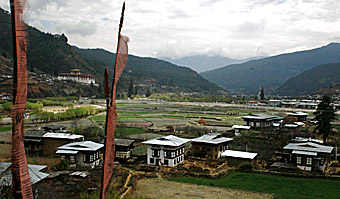 Appropriate, I think, since one often resorts to
prayer in trying to visit this exclusive destination. Which is one reason I feel
in the mood for a victory lap as I finally take my first steps in this
celebrated Shangri-la.
Appropriate, I think, since one often resorts to
prayer in trying to visit this exclusive destination. Which is one reason I feel
in the mood for a victory lap as I finally take my first steps in this
celebrated Shangri-la.
Bhutan is all the buzz these days. Amanresorts, famed for ultra-luxurious, ingeniously intimate, mega-expensive boutique inns, opened the $1,000-a-night Amankora a year ago in a land so unsullied it was the first foreign development.
Just not for long. In the fall, COMO, known for chic Metropolitan hotels in London and Bangkok, plus the plush Caribbean Parrot Cay, unveiled Uma Paro, bringing this remote land further into focus of jet-setters, fueling a media frenzy. The Bhutan Boom was on.
Hence, I arrive with great anticipation, and keen curiosity to discern what all the fuss is about.
Bhutan is festive from first view, colorful flags with Buddhist script adding an empyreal accent to what is surely the most heavenly – or hyped - destination of the day.
The pageantry, naturally, has nothing to do with my arrival. Rather it’s for Tsechu, the national festival, which annually rolls through Bhutan’s vivid towns, transforming each into even more electrifying displays of costume, dance, song and celebration.
Tsechu is still a week away in Paro, when I land at Bhutan’s only airport, a rare link to the outside world - and the present. Bags in hand, I exit to experience something akin to time travel.
Fronting the tarmac is…nothing. At least, from modern times. Wooly yaks drag wooden carts past fresh-plowed fields tended by folk wrapped in robes that may have been height of fashion, just a millenium ago.
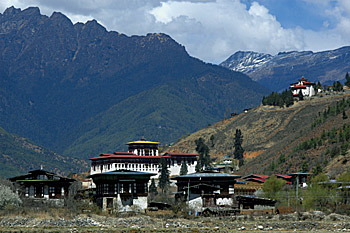 Equally dated mud-brick buildings dot hillsides undulating to a
backdrop of big-screen mountains under the clearest blue sky. Most are massive
old world wonders – remnants of Drukgyel Dzong, magnificent even with
mud-pounded walls fallen to ruin, 1400-year-old Kyichu Lhakhang temple, and Paro
Dzong, a citadel considered the finest example of Bhutanese architecture.
Equally dated mud-brick buildings dot hillsides undulating to a
backdrop of big-screen mountains under the clearest blue sky. Most are massive
old world wonders – remnants of Drukgyel Dzong, magnificent even with
mud-pounded walls fallen to ruin, 1400-year-old Kyichu Lhakhang temple, and Paro
Dzong, a citadel considered the finest example of Bhutanese architecture.
Dzongs are fortresses; practically every valley claims a Medieval-era castle, capable of withstanding sieges, housing not only lords but monasteries, too. Even now, the castles are city halls cum holy sites, but hardly look dated. That’s because, aside from cars on roads, everything in Bhutan is a perfect period piece, circa four or five centuries ago.
Change comes slowly to Shangri-la, for good reason. The incredible hardship of simply reaching this mountainous land has both protected and isolated a realm locals call Druk Yul, Land of the Thunder Dragon.
Even travel within the country is arduous, as visitors quickly - and queasily - discover. From Paro, starting point for nearly all 6,000 or so tourists allowed in each year, to the capital of Thimpu is 25 kilometers, but double that on roads reputedly featuring the most curves per kilometer.
Touring a country the size of Switzerland, atop the Himalayas, is a slow, yet satisfying process. You scale hills between towns, lurching as your jeep spins dirt on perilous hairpin turns.
Careening past rows of rice terraces, you finally summit and, no matter how often you do, cannot help but succumb to the view. Each valley is unique, but all are unencumbered by telephone lines, billboards or reminders of modern times.
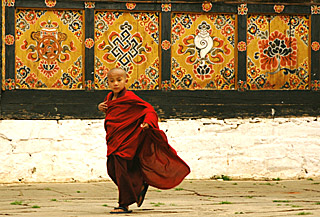 Herein lies Bhutan’s magnetic appeal to visitors,
as I repeatedly rediscover during a blissful 10-day tour. Instead of scenes
remotely resembling the outside world, Bhutan astounds with its
otherworldliness.
Herein lies Bhutan’s magnetic appeal to visitors,
as I repeatedly rediscover during a blissful 10-day tour. Instead of scenes
remotely resembling the outside world, Bhutan astounds with its
otherworldliness.
Every summit yields another fairytale castle, on a ridge or by a river, overlooking pristine terrain you thought existed only in history books, or films. Bhutan isn’t so much a kingdom as a string of them, each valley cradling a picture-book castle like a pearl in its own bucolic basin.
Yet, even by car, the 50-60 kilometer journeys between these beatific bowls remain exhausting all-day road trips.
This makes it all the more delightful to retire at night to deceptively-rustic Uma Paro, or eerily austere Amankora. Both bring five-star comfort to a country with few places worthy of any stars in the outside world. Not that anything in Bhutan can really be gauged in terms like anywhere else, as one quickly learns in Shangri-la.
“It’s a whole new ballgame,” says Stuart Campbell, snapping me back to reality from idyllic daydreams on the balcony of Uma Paro, where I have just checked in. Campbell is general manager of a lodge modeled on a traditional Bhutanese farmhouse, but with features that are anything but.
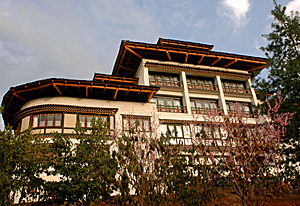 Deck chairs overlook blue
pines and, beyond, the entire Paro valley. Campbell ushers me down steps to
hot-stone bathhouses. Or guests can nip inside Shambhala, the British chain’s
own branded spa. Stays include treatments, plus daily stretches in a spacious
yoga room, wall-length windows showcasing the same serene views that lulled me
into rapture from the balcony above.
Deck chairs overlook blue
pines and, beyond, the entire Paro valley. Campbell ushers me down steps to
hot-stone bathhouses. Or guests can nip inside Shambhala, the British chain’s
own branded spa. Stays include treatments, plus daily stretches in a spacious
yoga room, wall-length windows showcasing the same serene views that lulled me
into rapture from the balcony above.
Conveniently sited near the airport, Uma looks the perfect country lodge, its 20 rooms arrayed around a cobblestone interior courtyard. There is a wood stove crackling in the library (with free broadband), and homey touches like heated towel racks in each room.
Nine villas provide heightened privacy amongst 38 acres of hilltop forest. Food blends fusion (tiger prawns basking in lemongrass and coriander, atop rice noodle salad; char-grilled pork and fennel sausages with potato masala and spicy mustard-onion chutney) with wholesome, local ingredients, like surprisingly succulent yak steak, served in a circular swirl of rough-hewn wood that could be the dining hall in any western ranch.
Campbell fits right in. Tall and ruggedly handsome, he hails from upscale wilderness retreats in Idaho and Montana. With wife Tracy Largent, who runs Uma’s wellness facilities, they have created a comfy, luxurious lodge that instantly feels like home.
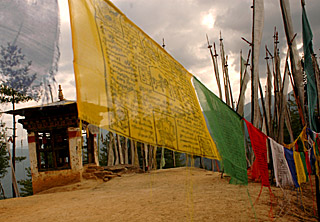 “This is just the start,” adds Campbell, describing Bhutan’s tourism blastoff,
as well as COMO’s plans. Like Aman, it plans to unroll a red carpet through this
infrastructure-challenged country for the well-heeled. Aman is already building
five more lodges in distant locations, but COMO will focus on luxury camps
nearby.
“This is just the start,” adds Campbell, describing Bhutan’s tourism blastoff,
as well as COMO’s plans. Like Aman, it plans to unroll a red carpet through this
infrastructure-challenged country for the well-heeled. Aman is already building
five more lodges in distant locations, but COMO will focus on luxury camps
nearby.
“People wonder what you can do during a week in Paro,” Campbell says, “but there is plenty of activity.”
Indeed, the options prove exhilarating. My itinerary includes temple tours, mountain hikes and a thrilling bike ride from Chelala, at 3900 meters, the highest point reached by road in Bhutan.
Shivering at the summit, surrounded by snow-cone peaks, I pedal past Himalayan Blue Pines, bouquets of wildflowers and thickets of poles spiked with flags all the way down the mountain.
The ride is 25 kilometers, a wild 60-minute flash to the valley floor of Haa, where a mountain biker must look as outlandish to residents as they to me, considering no tourists were even allowed in this lovely valley five years ago.
Most Bhutan tours typically start at Paro Dzong, a spectral citadel overlooking Paro’s
crystalline river. Above, are snow-dusted mountains. Prayer flags come in
various size and color, according to specific spiritual function; the entire
ensemble unfurls between old-growth pines shading a steep path to this
eerily-familiar redoubt; much of Bertolucci’s “Little Buddha” was set in a
picture-perfect castle where time is frozen still.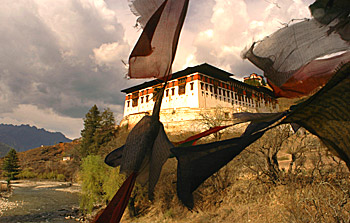
Wooden doors, tall and wide as a house, open to colossal inner courtyard, ramshackle with huge slabs of stone. Clerks with stacks of paper scurry out doors on one side, while the other is a kaleidoscope of color as chanting pilgrims mingle with maroon-clad youngsters, novices taking daily lessons in dark rooms, steeped in the smells and sensations of centuries. Outside, residents prepare fortress grounds for the carnival of Tsechu.
Paro is a one-street town, storefronts ablaze in vivid Bhutanese motifs. The patterns, trapezoidal temples and prevalent prayer wheels (some fronting stores - shop, spin, salvation!) look Tibetan. Both places are linked by Buddhist faith, customs and lineage.
Nobody really knows when people settled these mist-shrouded valleys, but nomads probably retreated from the Tibetan plateau three to four thousand years ago. Early inhabitants were Bon, devotees of animism. Buddhism was introduced by the Third Century and rapidly dominated every facet of life in what remains the only Buddhist kingdom since Tibet was swallowed by China and Sikkim by India.
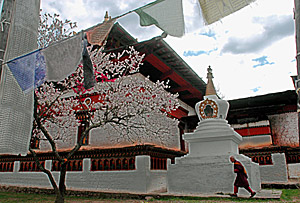 Despite Bhutan’s backwoods appearance, its people are remarkably well educated;
English is widely and well spoken. This facilitates remarkable interchanges
about aged mythology, which, like much of Bhutan’s vibrant past, remains in
currency.
Despite Bhutan’s backwoods appearance, its people are remarkably well educated;
English is widely and well spoken. This facilitates remarkable interchanges
about aged mythology, which, like much of Bhutan’s vibrant past, remains in
currency.
Walking me around Kyichu Lakhang, Paro’s most elegant temple, guide Dorje explains that it dates to the 7th Century, and a flurry of construction by King Songsten Gampo.
An ogress, he says, had swept over Bhutan and parts of Tibet, so the king built over 100 temples in a single day to pin the monster to the ground; Kyichu Lakhang nails down the leg.
Later, as I marvel over Taksthang Goemba, a group of gravity-defying golden temples, clinging to sheer cliff high above Paro, Dorje says, completely straight-faced, that revered Guru Rimpoche soared to the site atop a tigress; the name means Tiger’s Nest.
No aerial cats await pilgrims these days, so Dorje and I hike three kilometers, then 800 stone steps down and up a final, stunning gorge.
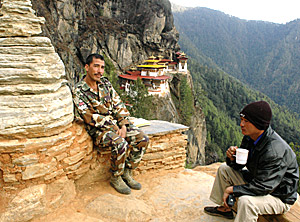 Huffing and puffing to
Bhutan’s most-photographed site, I cannot help but think it odd that, even
without a flying Tigress, Bhutanese manage to maintain world wonders at nearly 3,000
meters elevation, but cannot smooth the kinks from treacherous roads; the sole
“highway” is a rough strip of asphalt barely more than a car wide.
Huffing and puffing to
Bhutan’s most-photographed site, I cannot help but think it odd that, even
without a flying Tigress, Bhutanese manage to maintain world wonders at nearly 3,000
meters elevation, but cannot smooth the kinks from treacherous roads; the sole
“highway” is a rough strip of asphalt barely more than a car wide.
But priorities, like much in this quixotic realm, are enchantingly unlike elsewhere. So, it has fallen to foreign firms like COMO, owned by Singaporean Christina Ong, and Amanresorts, headquartered in Singapore, to usher in a new tourism era.
They are first-movers, but not alone. Roaming twisted roads between Paro and the capital of Thimpu, I spy many hotels rising. The burst of traffic has generated not just worldwide hubbub, but fresh concern over the impact of engagement after eons of purposeful hermitage.
That Bhutan is at a crossroads is apparent everywhere I go. Even visitors fret that a flood of fellow travelers will transform this precious Kingdom of Otherness into just one more groove on the map.
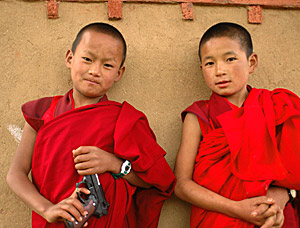 “The cat’s out of the bag,“
laments a guest at Amankora, which, more than any other development, has thrust
Bhutan into the global spotlight, attracting socialites from Cameron Diaz to
Hong Kong’s David “Shanghai” Tang, who rented the entire resort for a birthday
bash.
“The cat’s out of the bag,“
laments a guest at Amankora, which, more than any other development, has thrust
Bhutan into the global spotlight, attracting socialites from Cameron Diaz to
Hong Kong’s David “Shanghai” Tang, who rented the entire resort for a birthday
bash.
“Opening up, means no turning back,” the guest says, completely serious, between sips of Chilean wine. “Bhutan will be ruined.”
Not likely, counters Amankora manager John Reed. “This aura of Bhutan is strong,” he says. “This is such an amazing, unique destination. I don’t think our presence will have that much effect.”
Still, Aman created a stir with the opening of its first resort in Balakha Village at the far end of Paro Valley. Mixing stone walls with rammed-earth, Australian architect Kerry Hill built a modern village based on Bhutanese forms.
Sharp, crisp lines of mosaic walls recall Japanese minimalism, but Amankaro also reflects Drugyel Dzong, a hulking 17th century citadel left in ruin, on a hill above the resort. On clear days, 7,300-meter Mt. Jhomolhari, second tallest in the world, glows golden seemingly inches from the windows of the lobby, reached by a tiny doorway, at the end of a vast, stone plaza.
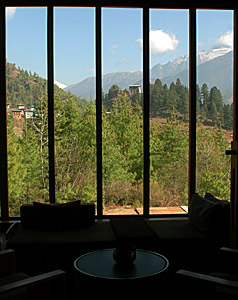 Practically all facilities
have an ethereal quality, tucked behind walls or buried beneath barely-visible
structures. The feeling is elegant simplicity so deceptive that it’s startling
to realize that, with 24 suites, this among Aman's largest
resorts. (The original design,
I am told, was
20 suites; four more were added to serve stranded guests. Before flying to
Bhutan, guidebook author Stan Armington had advised: “Bhutan is a place where delays
are often measured in days or weeks, not hours.”) A spa was added this summer.
Practically all facilities
have an ethereal quality, tucked behind walls or buried beneath barely-visible
structures. The feeling is elegant simplicity so deceptive that it’s startling
to realize that, with 24 suites, this among Aman's largest
resorts. (The original design,
I am told, was
20 suites; four more were added to serve stranded guests. Before flying to
Bhutan, guidebook author Stan Armington had advised: “Bhutan is a place where delays
are often measured in days or weeks, not hours.”) A spa was added this summer.
Four to a block, scattered amongst trees, suites have a rustic charm with wood-burning stoves inside rammed-mud and wood frame. Interiors are signature Aman, massively spacious with bathrooms big enough for basketball teams, around an ocean-liner sized tub. Linens are the finest weave, soaps and creams rich and plentiful. Inside, guests find native burlap bags and bamboo containers, but no TV, music system or mini-bar.
Meals are served country-style in a diminutive dining hall underneath the lounge. This is a departure for Aman, famed as much for exclusive getaways amongst beaches and rice fields of Bali and Phuket as its focus on privacy. I recall past Aman stays, in villas with private pool, never even sensing other guests.
Amankora styles itself a community of adventurers, albeit extremely wealthy ones. Guests cheerfully take to the setting, exchanging plans for rugged treks. Yet ambitious aims often alter.
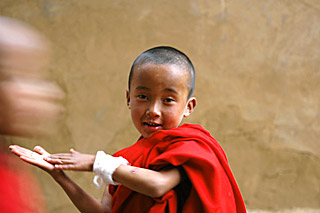 Typical is the experience of Steve, a
retired American judge. He enthuses about a three-day tour, only to return after
a single night in Punakha. “The hotel was cold and damp,” he confides. “My wife
couldn’t take it.”
Typical is the experience of Steve, a
retired American judge. He enthuses about a three-day tour, only to return after
a single night in Punakha. “The hotel was cold and damp,” he confides. “My wife
couldn’t take it.”
An Australian couple plan several outings but switch to tours of nearby temples and Paro walks. “The roads,” explains the wife, “are ghastly.”
Herein lies one dilemma for Bhutan, as it tries to transition from Medieval Age to hip destination in one quick bound. Aman and COMO raise the bar, bringing new creature comforts at considerable cost to this remote outpost, but they also lower it for high-rollers to whom money is no object.
Many come for the buzz and boast-factor - not necessarily the hardship, and huge gaps remain between expectation and delivery.
Then, there is the impact of sky-high-priced lodges in a land where wages average $2 per day. Aman, which spent 13 years negotiating its pioneering role, also brought Bhutan its first labor dispute. Staff walked out over pay, higher than at other hotels, but not by much.
“It was a huge misunderstanding,” sighs Reed, recalling a lose-lose situation. Raise salaries too much, and Aman would alienate other operators. Staff got more, but still mumble that guests pay more per night than they earn in a year.
 Other teething problems plagued properties that continually had to reinvent the
wheel in a resort backwater. Practically all material had to be imported;
likewise skilled workers. Bhutanese carpenters and electricians had no
familiarity with five-star lodges.
Other teething problems plagued properties that continually had to reinvent the
wheel in a resort backwater. Practically all material had to be imported;
likewise skilled workers. Bhutanese carpenters and electricians had no
familiarity with five-star lodges.
Then, there are local peculiarities. One COMO worker confides, completely serious, that staff sometimes call in sick “because their sister is possessed by a demon.”
First to start construction in 2002, and with loftier ambitions, Aman clearly faced more challenge, but may have compounded its problems. Touring some future Aman sites, I see they made fabulous picks, but Bhutanese are bitter about the proximity to a sacred site in Bhumtang.
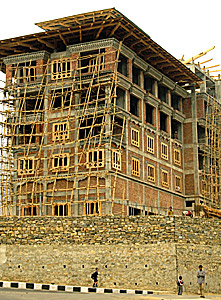 Aman initially advertised circuits of
the countryside, planning to refit some local lodges until its own properties
came on line. Only at the last-minute am I informed that my tour takes in the
same guesthouse that Steve despised (although, the Hotel Zangto Pelri was a
personal highlight; charming cottages had balconies that overlooked breathtaking
Punakha Valley, a part of Bhutan not to be missed.)
Aman initially advertised circuits of
the countryside, planning to refit some local lodges until its own properties
came on line. Only at the last-minute am I informed that my tour takes in the
same guesthouse that Steve despised (although, the Hotel Zangto Pelri was a
personal highlight; charming cottages had balconies that overlooked breathtaking
Punakha Valley, a part of Bhutan not to be missed.)
Bhutanese largely see luxury resorts as the next step in plans to ramp up tourism, focusing on low-volume, high-value visitors, says Thuji Dorji Nadik, joint director at the planning section of the Department of Tourism.
The five-year plan calls for a tripling of tourism from 5,000 visitors in 2002 to 15,000 in 2007. Early this year, Bhutan replaced its delightfully evocative but ancient 70-seat “Whisper Jets” with a pair of Airbus planes.
This greatly increases capacity at Druk Air, still the world’s smallest carrier. Seats on Shangri-la’s sole airline has proven a bigger constraint on tourism than minimum fees of $200 per day that shooed backpackers to neighboring Nepal.
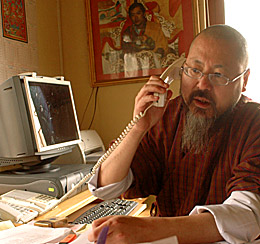 Nepal, where tourism is in a tailspin amidst a Maoist insurrection and power
seizure by an unpopular king, remains the yardstick by which most Bhutanese
measure the evils of mass-tourism, yet officials take an even harder tact.
Nepal, where tourism is in a tailspin amidst a Maoist insurrection and power
seizure by an unpopular king, remains the yardstick by which most Bhutanese
measure the evils of mass-tourism, yet officials take an even harder tact.
From Nadik up to prime minister, I find advocates for stricter limits. Nadik astounds me by pointing to Laos, often considered the shining example of how tourism can benefit an impoverished Asian nation.
“I was there a few years ago and was very disappointed. The main reason people were going to Laos,” he explains, “is that it is cheap. That’s something we definitely want to avoid.
“We’re very concerned about what happens, about boom and bust,” adds Nadik, stroking the wispy beard that gives him the look of an ancient Mandarin. “But we’ve only been going at this a short time. In the last few years, we’ve come like 200 years. Of course, there are going to be problems.”
James Hilton set his 1930s utopian novel, “Lost Horizon,” in an unspecified Himalayan realm, whose residents enjoyed a happiness, harmony and spiritual completeness lost in the rest of the world. Many see Bhutan as Shangri-la.
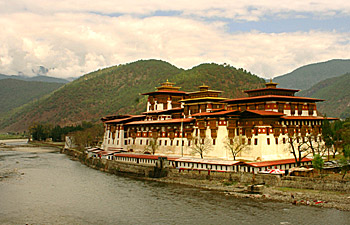 Locked away in self-imposed isolation, Bhutan didn’t even allow tourists until
the late 21st Century. Through the 1980s, tourism was limited to a few thousand
per year.
Locked away in self-imposed isolation, Bhutan didn’t even allow tourists until
the late 21st Century. Through the 1980s, tourism was limited to a few thousand
per year.
Until last year - what Nadik calls “a bumper harvest” - the record was in 2000, when visitors averaged a mere 20 per day. That soared, in Bhutanese terms, to 9,249 tourists last year.
“In the 1970s, you could count visitors on one hand,” Michael Rutland tells me one day in the midst of his mad commute from Paro to Thimpu. The curves are insane, but Rutland knows them like his hands on the wheel.
He’s the rarest foreigner; practically a native. When King Jigme Singye Wangchuck was a boy, Rutland came from Oxford to tutor the prince. For a quarter-century, he has spent part of each year here.
“Becoming more involved with the world was a conscious decision of the king,” says Rutland. Recent and highly-publicized changes – the internet and television were only allowed in 1999, mobile phones months ago – follow what Rutland believes was the first, most significant step, joining the United Nations.
A controversial census gave Bhutan an inflated population of over than a million, one benchmark for joining. More realistic counts suggest a population of around seven hundred thousand.
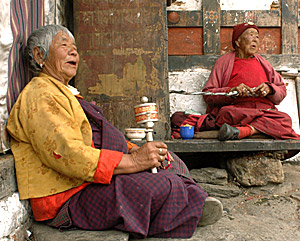 “Joining the UN was rather like the opening of a sluice gate,” muses Rutland of
the 1971 entry, likening it to a coming out party for the country. “People
imagine that all the change came with television and the internet, but the
changes really started in the 1960s.”
“Joining the UN was rather like the opening of a sluice gate,” muses Rutland of
the 1971 entry, likening it to a coming out party for the country. “People
imagine that all the change came with television and the internet, but the
changes really started in the 1960s.”
The process accelerated when the king assumed power; guesthouses and roads were built to accommodate outsiders invited to the coronation. That was 1972, the start of tourism, and my own initial enchantment with this fairytale kingdom.
It was senior year, and my American high school was part of a national Model United Nations. Four delegates from my school were chosen to represent a never-never land few even knew existed. Even now, I can still recite the mesmerizing details: Bhutan had three college graduates, fewer miles of paved road. I reveled in the national sport, archery. And what teen could not be captivated by an odd land whose sole export was postage stamps?
Even after a third-century of anticipation, when I finally arrive for my first visit, Bhutan measures up. Hearty treks to remote villages invariably lead to invitations to tiny temples and homes.
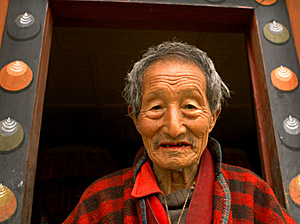 At Nobugang, aptly-named Jewel Hill, I stroll along gold-brown rice terraces
embracing green knolls, then scale steps to a magnificent monastery at the very
top.
At Nobugang, aptly-named Jewel Hill, I stroll along gold-brown rice terraces
embracing green knolls, then scale steps to a magnificent monastery at the very
top.
As I savor the view, a wrinkled old man appears, waving me to follow. Past rice ponds and pastures, he leads me to a small temple surrounded in stark-white banners. With shaking hand, he pulls a rusty key from the folds of the robe that provide every Bhutanese with a kind of kangaroo-pouch pocket.
Afterwards, he thanks me profusely for my visit, and a villager explains that a relative has recently died. By coming to visit, I have honored him so.
This proves a common, rather than unusual encounter. I’m continually thanked for visiting Bhutan, for poking my head inside someone’s house, for taking pictures. Bhutanese at every level are warm, generous, eager to engage.
In the hills above Wangdue, a group of schoolchildren take me by hand, then guide me around their village. As repayment, they ask not for candy or pens, but a letter to be sent later, then take turns meticulously scribbling their names in my notepad.
Set on a river, Wangdue’s dzong may be Bhutan’s finest. “Once people come to this dzong,” Dorje says, “they don’t want to visit anymore.”
The rounded fortress even has an antique wooden drawbridge. Outside, adding authenticity to a land where none is lacking, I luck into my first archery competition.
Muscular men in day-glow robes fire arrows at targets 150 meters distant in spirited matches that, like cricket, regularly run to three-day tests. Aside from metal bows, a modern innovation, everything could be borrowed from a production of Sherwood Forest, only the Shangri-la version.
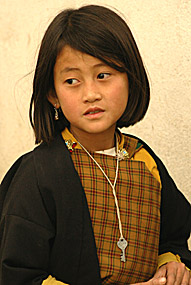 Some say Bhutan is a repressive realm where serfs are forced into the roles of
fairytale subjects in a contrived Himalayan Disneyland. Indeed, much seems
believe-it-or-not in Bhutan, including the gear – the gho, a silk dressing gown
with upturned cuffs for men, and the kiri, a sari worn by women over a
wraparound skirt.
Some say Bhutan is a repressive realm where serfs are forced into the roles of
fairytale subjects in a contrived Himalayan Disneyland. Indeed, much seems
believe-it-or-not in Bhutan, including the gear – the gho, a silk dressing gown
with upturned cuffs for men, and the kiri, a sari worn by women over a
wraparound skirt.
A 1989 decree created this national costume drama, all the more outlandish with knee-length socks tucked into an array of plastic sandals, leather oxfords, Pumas and Nikes.
Yet, nobody I talked to, from farmer to educated landowners, seemed bothered by the Sunday School attire. Nor were many perturbed by recent measures sure to raise hackles anywhere else.
The world’s first national ban on cigarettes went into effect in March, the same month the king issued a draft of Bhutan’s first constitution, aimed at replacing his own rule with democracy.
That’s something you never find in the Real World - a ruler willingly giving up power.
Not that his people are pleased. “We’ve been fine all these years with a king, why change things?” I hear it over and over again.
Good sense has guided Bhutan for almost a century, since infighting between the Desi, local kings, gave way to the monarchy in 1907.
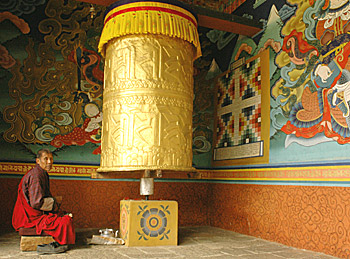 Since then, Bhutan has been
blessed with a series of remarkably good kings, a roll of the royal DNA that
current King Wangchuck isn’t keen to risk.
Since then, Bhutan has been
blessed with a series of remarkably good kings, a roll of the royal DNA that
current King Wangchuck isn’t keen to risk.
Probably 98 percent of the population line up in typical Bhutanese show of unity – only in rare disagreement; they want the king to retain the throne.
Yet, he has proven a visionary time and again. Long ago, the king began gauging success not by material wealth but well being, Gross National Happiness over Gross National Income. Bhutan, in GNH terms, has to be by far the world’s richest place.
Maybe it’s the magic of Tsechu, but for a full week, I see nothing but smiles, hear no children cry, am showered in GNH. Except from my sometimes companion, Lynne O’Donnell, a reporter I know from a posting in Beijing.
Now based in London, she flies in seemingly intent on exposing this sham Shangri-la. If I’m overly intoxicated by a land I’ve waited much of my life to behold, Lynne keeps me in check and compensates by seeking desperately to burst Bhutan’s bubble.
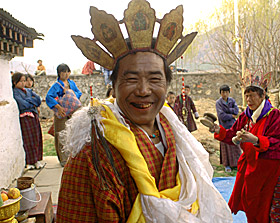 However, as the days wear on,
even Lynne wears down. “I just don’t get it,” she admits wearily near the end of her
tour. “It doesn’t seem real.”
However, as the days wear on,
even Lynne wears down. “I just don’t get it,” she admits wearily near the end of her
tour. “It doesn’t seem real.”
Of course, it’s not perfection. “I dismiss all the talk of Shangri-la as nonsense,” Rutland says. “Bhutanese are human, and human nature is the same in Manhattan or the Himalayas. How it manifests itself, though. That’s the difference.”
Later, he adds that greed has never been a problem because Bhutanese essentially all had much the same. “But that’s changing,” he concedes. “And it worries me.”
Nor are the unsettling signs altogether unsubtle. During my visit in March 2005, two COMO staff are assaulted by local youth outside a bar in Paro. One suffers broken ribs, the other is stabbed.
The month before, laborers at a bank expansion notice a remarkable routine. Men go into another room, open a door, come out with sacks of cash. They return at night, creep to the door, turn the handle, and… nothing.
Some sort of mystery wheel (a combination lock) stymies their get-rich scheme. Worse, they are surprised by a guard. Scuffling, they stab him. Bhutan experiences not only its first attempted – and failed – bank robbery, but an almost unheard of capital crime.
Such events suggest Bhutan isn’t really different than other places, only behind the times. Kinley Dorji, editor of Bhutan’s only independent newspaper, has questioned the luxury inns, but says they aren’t to blame.
“Whether people are paying $200 or $2000 doesn’t really matter. What’s the difference to Bhutanese between rich, and richer?”
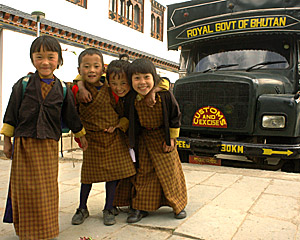 The contrast registers with a select few, like Topgyal Dorji, or Lord Precious
Jewel. “In the 21st Century, it’s time for Bhutan to be part of the world,” he
says, lighting a cigar in the bar of the Uma Paro, paying no mind to the new
anti-smoking ban.
The contrast registers with a select few, like Topgyal Dorji, or Lord Precious
Jewel. “In the 21st Century, it’s time for Bhutan to be part of the world,” he
says, lighting a cigar in the bar of the Uma Paro, paying no mind to the new
anti-smoking ban.
The land around the Uma is his, “so this is my house,” he says smiling. His family has, since the start of time, ruled Haa, where I took my bike ride, and are big property owners. Hence, they stand to profit from the opening to tourism, especially well-endowed ones Uma attracts.
Jewel’s family is also building what will be Bhutan’s largest hotel in Thimpu, and hope to have Indian chain Taj manage it.
Still, he prides himself as a benefactor. “What we have is a kind of wealth you don’t see elsewhere, a harmony and happiness others envy. We must share it.”
Not so far-fetched, says American folklorist and art historian Andrew Conners. “I think Bhutan has a lot of lessons to teach the world,” he says at Paro Tsechu, amidst the wildest dancing and folk opera imaginable.
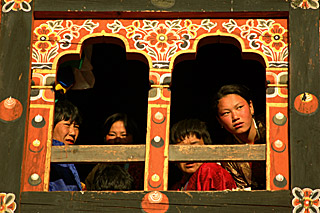 Conners scouts for the
Smithsonian, which plans to bring over a hundred Bhutanese – singers, dancers,
oracles, craftspeople and farmers– to Washington DC as part of an annual
celebration of different places. Bhutan will be recreated before an expected 1.5
million people in June 2008.
Conners scouts for the
Smithsonian, which plans to bring over a hundred Bhutanese – singers, dancers,
oracles, craftspeople and farmers– to Washington DC as part of an annual
celebration of different places. Bhutan will be recreated before an expected 1.5
million people in June 2008.
Bhutan-mania! Blessing or curse? That’s the question everywhere I go, but it sets my head swimming. So, on my final day in Shangri-la, I leave the noisy euphoria of Tsechu for the serenity of Taksthang Goemba.
Closed for years of renovation after a fire, the complex is to reopen tomorrow. By coincidence – Dorji prefers destiny – I have it to myself, except for monks preparing relics for transfer to Tsechu, and the temple for consecration by the king tomorrow.
As a result, doors are open that normally stay shut save one day per year, or decade. I’m ushered inside crusty old shrines carved in caves, bathed in holy water, blessed.
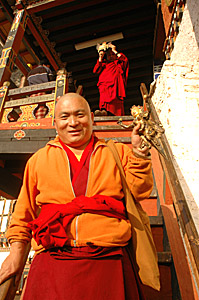 Dorje practically has to drag me down the mountain. In a rare reversal of roles,
I’m no longer in a rush. My short stay in Shangri-la is nearly over, but I have
been drenched in the wisdom of centuries, and feel truly blessed.
Dorje practically has to drag me down the mountain. In a rare reversal of roles,
I’m no longer in a rush. My short stay in Shangri-la is nearly over, but I have
been drenched in the wisdom of centuries, and feel truly blessed.
Dorje, though, is part of a Bhutan’s new tourist generation. He doesn’t need to drink from a spiritual chalice to realize it would be unwise to descend Tiger’s Nest, and lose a lightheaded tourist to the gorge.
“What are you thinking?” he asks suddenly as we stumble down the mountain side. I realize my smile must be immense. I’ve been daydreaming, recalling my arrival, when I was greeted at the airport by a woman from Uma Paro.
Then, I was the eager reporter, and she offered insights to a transition. “Before, I worked at a travel agency,” she told me. “We came in at 10, took an hour or so for lunch and left at 4 p.m. Now, we have to work nine hours a day. It’s all hurry, hurry, hurry.
“To be honest,” she added. “Before, in Bhutan, there was never any reason to hurry.”
But now, Bhutan is on track to be like everywhere else. Thankfully, I think, as we descend from the magical monastery, this remote land still has a long way to go. And more than flying tigers to guide it.
Ron Gluckman is an American journalist who has been living in and covering Asia for 15 years. Currently based in Bangkok, he visited Bhutan for a feature in the October/November 2005 issue of DestinAsian Magazine. This is the longer, original draft of that story.
Ron notes: "Two months before I left for Bhutan, the New York Times ran a story headlined: 'Why Is Everyone Going to Bhutan?' The implication being that this tiny nation was suddenly trendy. Just for the record, I caught the Bhutan buzz more than three decades before when, as a 17-year-old student at Lick Wilmerding High School in San Francisco, I helped represent Bhutan to the Model United Nations. And what kid wouldn't be captivated by a country whose national sport was - and still is - archery, and only export was postage stamps. Needless to say, Bhutan lived up to my wildest dreams. Do yourself a favor --- go see for yourself."
All pictures by Ron Gluckman
To return to the opening page and index
push here
[right.htm]
